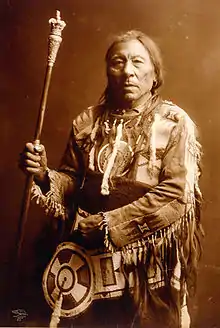Siksika Nation
The Siksika Nation is a First Nation in southern Alberta, Canada. The name Siksiká comes from the Blackfoot words sik (black) and iká (foot), with a connector s between the two words. The plural form of Siksiká is Siksikáwa. The Siksikáwa are the northernmost of the Niitsítapi (Original People), all of whom speak dialects of Blackfoot, an Algonquian language.
 | |
| People | Blackfoot |
|---|---|
| Treaty | Treaty 7 |
| Headquarters | Siksika |
| Province | Alberta |
| Land[1] | |
| Reserve(s) | |
| Land area | 710.875 km2 |
| Population (2020)[2] | |
| On reserve | 4120 |
| On other land | 2 |
| Off reserve | 3412 |
| Total population | 7534 |
| Government[3] | |
| Chief | Ouray Crowfoot |
| Website | |
| siksikanation.com | |
When European explorers travelled west, they most likely met the Siksiká first and assumed all Niitsítapi of the Blackfoot Confederacy were Blackfoot, which is incorrect. The four Niitsítapi nations of the Blackfoot Confederacy are the Siksiká, Káínaa (Kainai or Blood), Aapátohsipikáni (Northern Peigan), and Aamsskáápipikani (South Peigan or Montana Blackfoot). The approximate population of the Siksika Nation, as of 2009, is 6,000 people.[4]
Economy of the Siksika Nation
The Siksika government applied for a licence to produce Medical Marijuana in April 2016. They anticipate generating $14.2M in annual revenue. The Siksika Resource Development Ltd, and Siksika Herbz Ltd partnership plan to construct 25,000 Sq ft facility East of Calgary. Revenue generated will also be donated to support social services. The Siksika intend to distribute the medication domestically and internationally.[5]
Location
The Siksika Nation reserve, Siksika 146, is located approximately 95 km (59 mi) east of Calgary, and 3 km (1.9 mi) south of the Trans Canada Highway (Highway 1). Its administrative and business district is located adjacent to the community of Gleichen.
Land claims

The Siksika Nation has had a longstanding land claim dispute with the Government of Canada over events dating back to 1910. The government sought the cession of approximately 46,621.4 hectares (115,204 acres) of land within the Siksika Indian Reserve for sale by the federal government to incoming settlers. The cession included 5,067.6 hectares (12,522 acres) of reserve lands to be transferred to the Canadian Pacific Railway, for construction of the Bassano Dam. The band members were not adequately informed about this portion and lost the use of the surface rights of the land. The Nation claims the transfer was done illegally. In 1980, the government admitted that no proof existed that Canadian Pacific had acquired the rights to the land for the dam.[6]
The Nation entered into negotiations with the Canadian government to settle the land claim. In 1991, the Siksika Nation signed a $4.9m agreement with the government for compensation for mineral rights lost due to construction of the dam. In 2010, the Nation finally reached agreement with the governments of Canada and Alberta to settle the land claims. The band would receive $50 million and new water rights.[6] The money will be put in a trust to benefit the Nation for purposes such as education and welfare.
Notable people
- Crowfoot, chief of the Siksika Nation (c. 1885) and a signer of Treaty 7.
- Aatsista-Mahkan (Running Rabbit), portrayed in photo by Edward S. Curtis.
- Robin Big Snake, former professional hockey player, most recently with the Muskegon Lumberjacks during the 2009-10 International Hockey League season.
- Armond Duck Chief, country singer and songwriter.
- Rilee Many Bears, athlete.
- Gerald McMaster, artist, curator, and author.
- Adrian Stimson, interdisciplinary artist, 2018 Governor's General award winner in visual and media arts.
Gallery
 Sahpo Muxika, also known as Crowfoot, Head Chief of the Siksika, ca 1885
Sahpo Muxika, also known as Crowfoot, Head Chief of the Siksika, ca 1885 Curly Bear, a Siksika chief, 1903
Curly Bear, a Siksika chief, 1903 Aatsista-Mahkan, circa 1900, by Edward S. Curtis
Aatsista-Mahkan, circa 1900, by Edward S. Curtis Gerald McMaster, 2009
Gerald McMaster, 2009
References
- "First Nation Detail". Indigenous and NortOh hern Affairs Canada. Government of Canada. Retrieved September 10, 2019.
- "First Nation Detail". Indigenous and NortOh hern Affairs Canada. Government of Canada. Retrieved September 10, 2019.
- "First Nation Detail". Indigenous and NortOh hern Affairs Canada. Government of Canada. Retrieved September 10, 2019.
- "Oki (Welcome)". Official Website of the Siksika Nation. 2009 (retrieved 12 December 2009)
- Brooks, A (Nov 4. 2016) 'Siksika Nation eyes pot production facility'.Calgary Sun, Retrieved from http://www.calgarysun.com/2016/11/04/siksika-nation-eyes-pot-production-facility, Retrieved on Nov 7, 2016
- Kelly Clyderman (2010-12-12). "Deal would give native band over $50 million in land dispute". Montreal Gazette. Archived from the original on 2010-12-16. Retrieved 2010-12-24.
External links
| Wikimedia Commons has media related to Siksika Nation. |
